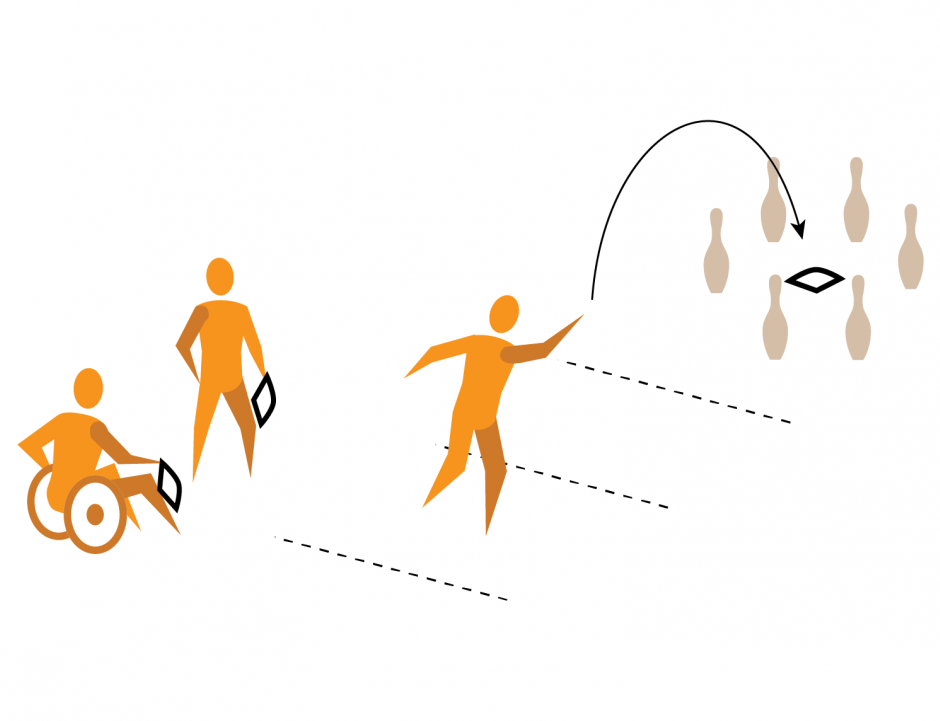TGfU Category: Target Games
Locations: gymnasium, multipurpose room, outdoor space (e.g., field, tarmac)
Game/Sport Connections
Target games are activities in which players send an object toward a target while avoiding any obstacles. By playing these games, participants develop skills and tactics to play other target games or games that require the application of similar skills, concepts, and strategies (e.g., archery, bocce, bowling, croquet, curling, golf, horseshoes, shuffleboard, Snow Snake).
Activity Overview
Participants learn about and practise sending an object toward a target surrounded by bowling pins from different distances.
Key Movement Skills, Concepts, and Strategies
Throughout the activity, consider highlighting the following skills, concepts, and strategies for effectively sending an object toward a target. Note that this list is not exhaustive and further learning opportunities may arise during the task.
Movement Skills and Concepts
Manipulation skills and effort awareness: applying a controlled force to send an object toward the target (e.g., swinging the sending arm back while stepping forward with the opposite foot to the sending arm and leaning slightly over the extended front foot).
Movement Strategies
- Applying appropriate skills to be proficient at hitting the designated target (e.g., using different amounts of force depending on the distance from the target).
- Developing an understanding of the skills needed to improve proficiency as the distance increases from the target (e.g., gaining an awareness of body position and how the movement of different body parts affects the underhand throw).
Considerations
- Incorporate some or all of the variations listed in the “Variations” section while planning the activity. This will help to best meet the diverse backgrounds, identities, needs, and interests of participants and maximize the fun, inclusion, participation, and success of everyone.
- To elevate participant voice and choice, periodically pause the activity and share the variations with participants. Ask them to determine how they would like to change the activity to maximize the fun, inclusion, meaningful participation, and success for everyone. Encourage participants to add any variations of their own.
Equipment
- 1 object to send that does not easily roll per participant (e.g., beanbag, rubber chicken, sponge ball)
- 3 cones or pylons per group
- 6 bowling pins or empty plastic water bottles per group
Safety
- Inspect the equipment and activity area to identify and remove hazards. Check that the activity surface provides sufficient traction.
- Establish the boundaries for the designated playing area at a safe distance from walls and obstacles. Share the boundaries with participants.
- Review the safety rules and activity instructions with participants prior to the activity.
- Instruct participants to be aware of their surroundings, including the locations of other participants during play.
How to Play
- Divide participants into small groups (e.g., 2 – 4). Note that this game can also be set up for parallel play.
- Using bowling pins or empty plastic water bottles, participants set up a circle in their designated playing area (approximately one metre in diameter). This circle is their target. Participants can make their target larger or smaller at any time during play.
- Participants place 3 cones or pylons at various distances from their target to identify 3 sending lines. Participants can choose to increase or decrease the distance of the sending lines from their target at any time during play.
- Participants choose an object to send (e.g., beanbag, rubber chicken, sponge ball) and take turns sending (e.g., slide, underhand/overhand throw) their object into their target without knocking down any of the bowling pins. Participants can change their sending object at any point during play.
- Participants retrieve their object after every attempt.
- Participants choose to start from any of the 3 sending lines or start at the closest distance and move farther away from their target with each successful attempt.
- Participants keep track of how many attempts it takes to get the object into their target from each distance. Participants can choose to work together to be successful at hitting their target.
- Once a participant has been successful at hitting their target from each sending line, the participant starts at the first sending line and attempts to complete the game with fewer attempts. If the participant/group chooses not to track the number of attempts, they continue play.
- After a period of play, provide participants with some or all of the variations. Ask them to decide how they might change the game to enhance their fun, challenge, and success. Encourage participants to add any variations of their own.
- Consider having groups share their variations and select another variation to try with their group.
Image: Visual Depiction of the Activity Instructions

Pause for Learning
Throughout the activity, ask open-ended questions to help participants refine their movement skills, strategies, and tactical solutions. Examples include:
- Which body parts move—and in which ways—when you send your object to your target?
- What can you do to avoid knocking down bowling pins or plastic water bottles?
- What do you have to do to send the object from the farthest sending line? How does your strategy change when sending the object from the nearest sending line?
- Which games or sports have you played or know about that use similar rules and strategies to the ones used in this game?
Variations
- Use the non-dominant hand to send the object.
- Attempt to send the object in various ways (e.g., standing on one foot, one eye closed, from a seated position).
- Attempt to knock down the bowling pins or plastic water bottles one at a time to gain points as a group.


